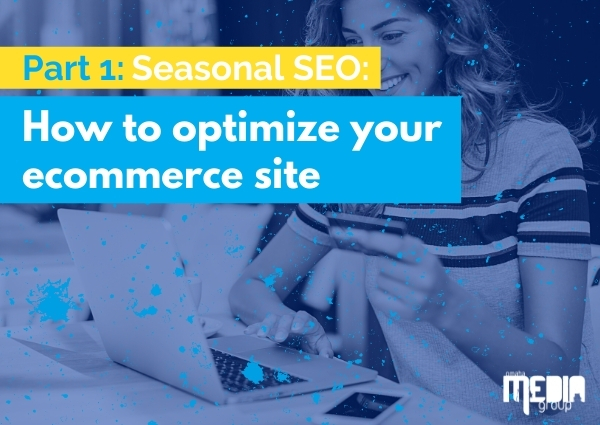PART 1: Seasonal SEO: How to optimize your ecommerce site
 https://www.omahamediagroup.com/images/uploads/monster_gallery/Omaha-Media-Group-Black.jpg
https://www.omahamediagroup.com/images/uploads/monster_gallery/Omaha-Media-Group-Black.jpg

The festive holiday shopping season is fastly approaching, and before ecommerce companies know it, it will be October 1st. Now is the prime opportunity for ecommerce retailers across any sector to increase their bottom line while ensuring their efforts are properly optimized.
The world of online shopping continues to grow at a rapid rate. With the pandemic, consumers quickly switched their shopping behavior, and the ecommerce industry’s growth surpassed its original forecast of 2020. In 2020, we spent over 44 percent more than in years past on online shopping.
And as we continue into the unknown, the figures from Q1 2021 show that the pandemic is still making an impact, with spending increasing 39 percent year over year.
With this in mind, it is imperative that all ecommerce companies ensure that their Golden Quarter is the best one yet. Although the rise of sales and competition can make it difficult for companies to hit their goals, seasonal ecommerce SEO can help with this.
Here are all of the top tips for seasonal ecommerce SEO that companies should have had implemented!
Plan ahead of time
Here is your reminder to start planning your seasonal omnichannel marketing strategy right now. A great example is Halloween. The spookiest time of the year shows that consumers start shopping for their fall and Halloween items around September, and the peak weeks include the first two weeks of October.
The current Supply Chain and Logistics can be difficult, and with the rise of online purchases, it is important to plan for setbacks in your supply chain and logistics plans this season. This means ensuring proper delivery dates, having enough inventory for shoppers, figuring out which holidays you are doing promotions for, marketing campaigns and a list that goes on and on.
Navigation
Website navigation is how users will access different parts of our website. This means traveling from product to product or from the product to the check-out process. The biggest notion to remember when it comes to navigation is that it needs to be easy to move from page to page of the website, or in an ecommerce case, from product to product.
From here, it is important to be able to click on products, immediately see products, and have the ability to filter or use the right-hand side navigation to find specific products.
Once navigation is in place, it is time to ensure that extra products and pages aren’t slowing down the website.
Loading speed
It is estimated that websites have less than 0.05 seconds before a consumer makes a judgment about the website. In the ecommerce industry, this is the difference between a sale and another lost sale.
A great example of the importance of loading speeds is a case study with Amazon. Amazon notices that when their website took one second longer to load than normal, they were losing over $6 billion in sales. Yes, one second of a difference in loading speeds, and the company (who already makes billions of dollars) lost $6 billion.
How much money could small to large ecommerce companies be losing each year due to a website loading one second too late?
What can companies do to ensure that their website loads quickly during and after the holiday season?
- Make sure code is cleaned up
- Images are compressed
- Unnecessary pages are removed
- Update WordPress templates
- Make sure it is responsive
While a company is cleaning up its website or improving its loading speed, a great way to condense pages is by reviving old and relevant landing pages.
Revive old landing pages
A great landing page can be one of the biggest marketing hacks when it comes to any marketing campaign. A great example of how a landing page can be utilized for sales and promotions when it comes to ecommerce is Home Chef.
It was difficult to find the right promotion code when typing in “Home Chef promo” into Google, but once we found it, the link takes us to a landing page through Google Ads that are tracking, reporting, and showing all results of this promotion on the landing page.
You can tell from the advertisement, but from the link as well. The landing page has their rating, the ability to pick your meals, the offer in red above all of this, and the ability to scroll and learn more.
Research shows that in the ecommerce industry, landing pages do not always provide the sales that companies are searching for, but this can also be due to a lack of information. The rest of this page provides small blurbs of the company and keeps using the “Pick Your Meals” CTA to grab the attention of the customers.
These are the beginning stages of seasonal ecommerce SEO! While we didn’t directly speak about keywords or other commonly known topics in SEO, these elements all need to be set in place to ensure that your seasonal ecommerce SEO strategy is effortless. In Part 2, we will be discussing URLs, keywords, cross-cannibalization of content and keywords, and other elements.
Put these ecommerce seasonality strategies to work with our help. Omaha Media Group is experienced in ecommerce websites and digital marketing efforts. For more information, contact us today.
It's the most wonderful time of the year to start SEO!
Let's chat!Posted In: SEO and Search Marketing


























